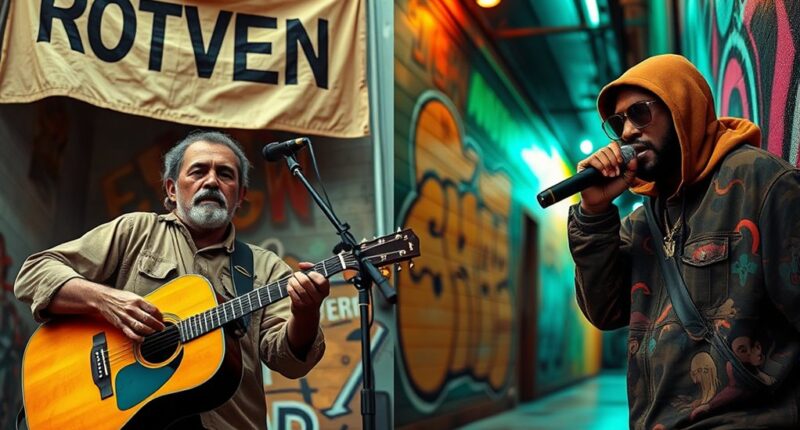Protest music started with folk songs in the 1960s, using simple melodies and storytelling to voice social struggles. As the movement grew, artists adopted electric instruments and protest rock to amplify their messages. Later, hip-hop and rap emerged from urban communities, giving marginalized voices a powerful platform through rhythm and lyrical expression. Today, digital platforms and diverse genres continue to expand protest music‘s reach, shaping society in new ways—if you explore further, you’ll discover how these changes influence activism and policy.
Key Takeaways
- Protest music originated with folk artists using simple melodies and storytelling to rally social movements in the 1960s.
- The shift to electric instruments in folk and rock amplified protest messages and created iconic anthems like “Blowin’ in the Wind.”
- Urban genres like hip-hop emerged in the 1970s, using rhythmic speech and cultural expression to address social issues and identity.
- Digital platforms and genre blending in modern times have democratized protest music, fostering diverse voices and global activism.
- Contemporary protest music combines styles such as punk, hip-hop, and folk, utilizing electronic production to address social justice worldwide.
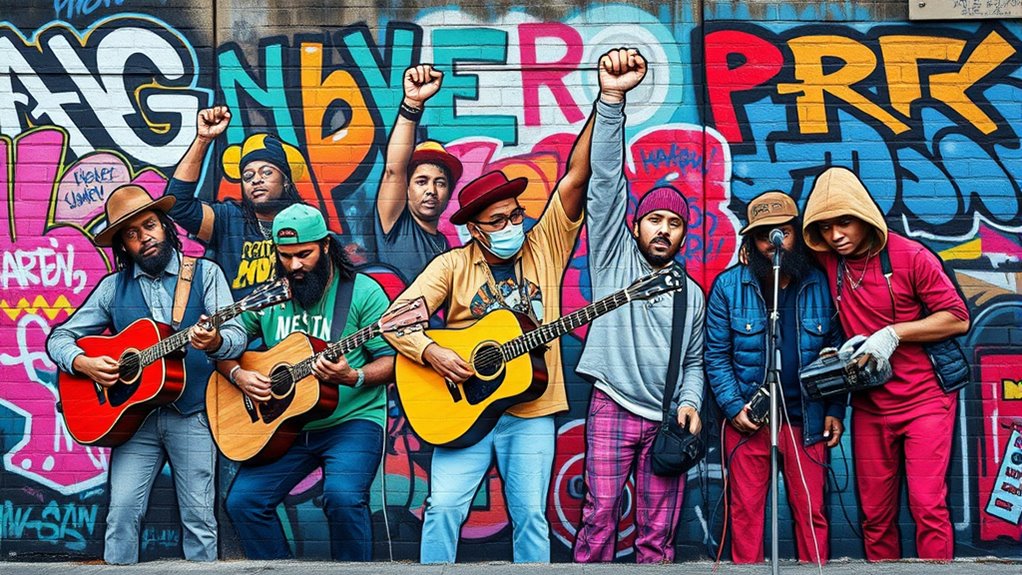
Folk music has long served as a powerful tool for social change, capturing the voices and struggles of ordinary people. It reflects cultural identity, preserving traditions and stories that unite communities. Through musical innovation, folk artists crafted new sounds that resonated with social movements, making their messages more impactful. By blending traditional melodies with contemporary influences, they created accessible tunes that spoke directly to people’s experiences. This fusion helped sustain a sense of unity during times of upheaval. As a result, folk music became a rallying cry for justice, equality, and change. Its ability to adapt while maintaining cultural roots made it a crucial force in shaping social movements, inspiring others to voice their concerns through accessible, meaningful music. Additionally, the use of musical innovation enabled folk musicians to reach broader audiences and amplify their messages more effectively.
The 1960s: Folk Artists as Voice of Change

During the 1960s, folk artists harnessed their music as a powerful voice for social change, capturing the turbulence and hope of the era. They used musical innovation to craft compelling melodies and lyrics that resonated deeply with audiences. Your engagement grew as listeners connected emotionally, feeling part of a larger movement. These artists:
- Employed simple, memorable melodies to reach wider audiences
- Integrated storytelling to deepen emotional impact
- Used live performances to energize protests and rallies
- Adapted traditional folk sounds with modern influences
- Became spokespeople for civil rights, anti-war, and social justice causes
- Leveraged market research to understand what themes resonated most with their audiences
Their authentic message and innovative approach transformed folk music into a essential tool for activism, inspiring generations to come.
The Shift to Electric and Protest Rock
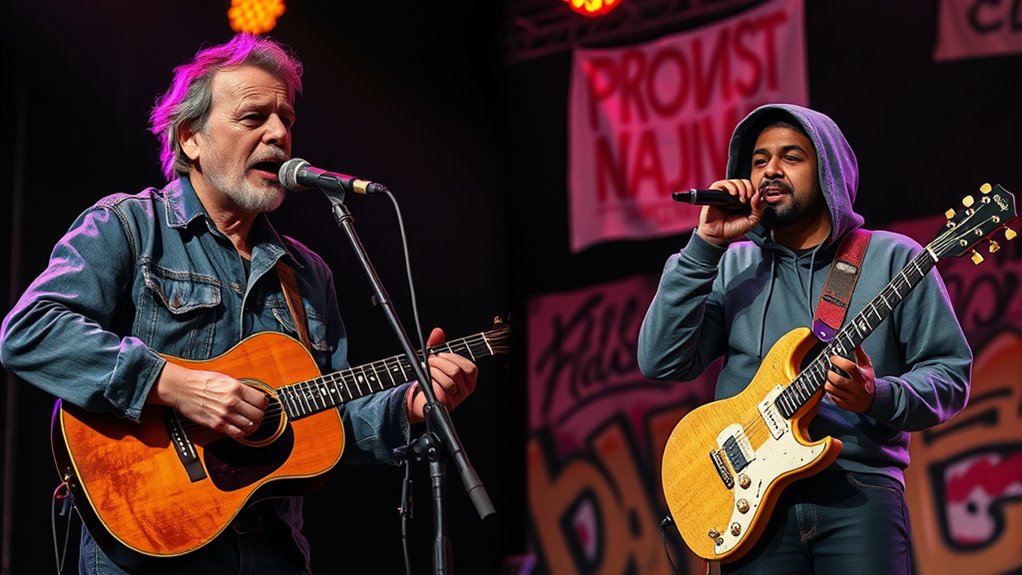
You notice how electric instruments amplified the voices of protest, making the message louder and more powerful. Iconic anthems like “Blowin’ in the Wind” and “Fortunate Son” rally people and define the era. This shift transforms protest music into a force that resonates across generations, influenced by the evolving musical landscape that continues to shape activism today.
Amplification of Voices
The shift to electric instruments and protest rock dramatically amplified the voices of artists seeking social change. With louder, more powerful sounds, your message reaches wider audiences and sparks greater audience engagement. This era transforms music into a tool for cultural identity, uniting listeners through shared struggles and values. You see artists using electric guitar riffs and energetic performances to challenge the status quo. Additionally, the use of awards and global accolades helped elevate protest music, giving it more recognition and influence on an international scale.
Iconic Protest Anthems
What makes certain protest songs resonate across generations? It’s their powerful musical storytelling and lyrical activism. Iconic protest anthems shifted from folk to electric, amplifying messages with bold sounds. Songs like “Blowin’ in the Wind” and “Born to Run” became rallying cries, inspiring collective action. These anthems used electric guitars and drums to energize movements and reach wider audiences. Their enduring impact lies in simple, relatable lyrics paired with compelling melodies. To see how these songs connect, consider this table:
| Song | Artist | Message |
|---|---|---|
| “Blowin’ in the Wind” | Bob Dylan | Peace, Civil Rights |
| “American Idiot” | Green Day | Anti-war, Anti-establishment |
| “Get Up, Stand Up” | Bob Marley | Rights, Resistance |
| “Fortunate Son” | Creedence Clearwater Revival | War critique |
| “Killing in the Name” | Rage Against the Machine | Authority challenge |
These anthems exemplify how electric sounds fueled lyrical activism across generations. Additionally, electrification of protest music allowed for greater emotional intensity and broader dissemination, making these songs timeless rallying cries.
The Rise of Hip-Hop and Urban Expression
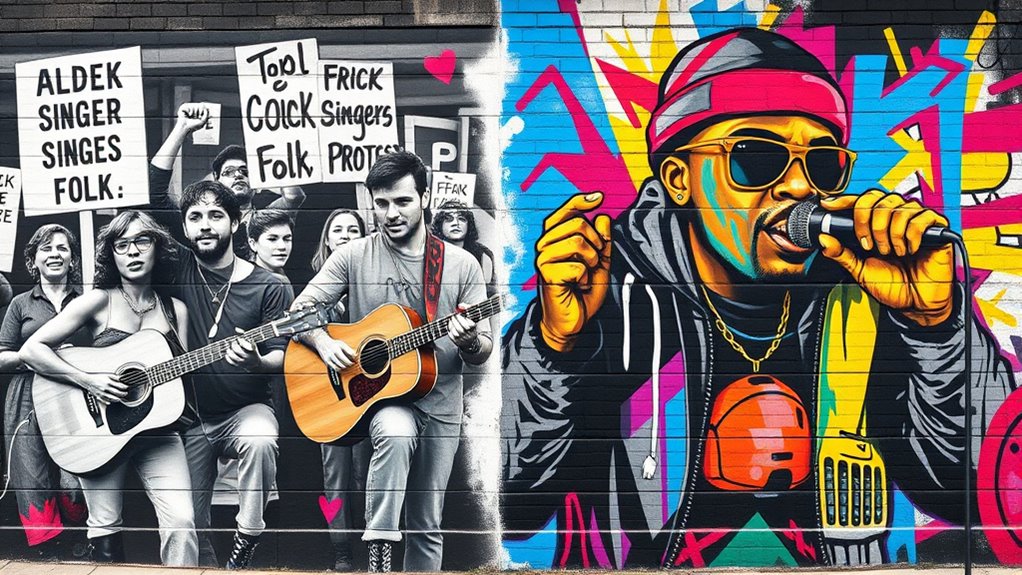
As hip-hop emerged from urban communities in the 1970s, it quickly evolved into a powerful platform for expressing social issues and cultural identity. You see, it’s not just about the beats; it’s about telling stories that matter. Hip-hop’s musical innovation gave voice to marginalized groups, shaping a new cultural landscape. You might recognize how artists used their lyrics to highlight struggles and hopes, making the genre a tool for activism. Here’s what made hip-hop influential:
- Combines rhythmic speech with innovative production techniques
- Creates a sense of cultural identity for urban youth
- Addresses social injustices directly
- Influences fashion, language, and attitudes
- Builds a community around shared experiences
Additionally, the genre’s use of wall organization created visually compelling ways to communicate messages and organize social commentary. Hip-hop’s rise transformed protest music, making it relevant and revolutionary.
Rap as a Platform for Marginalized Communities
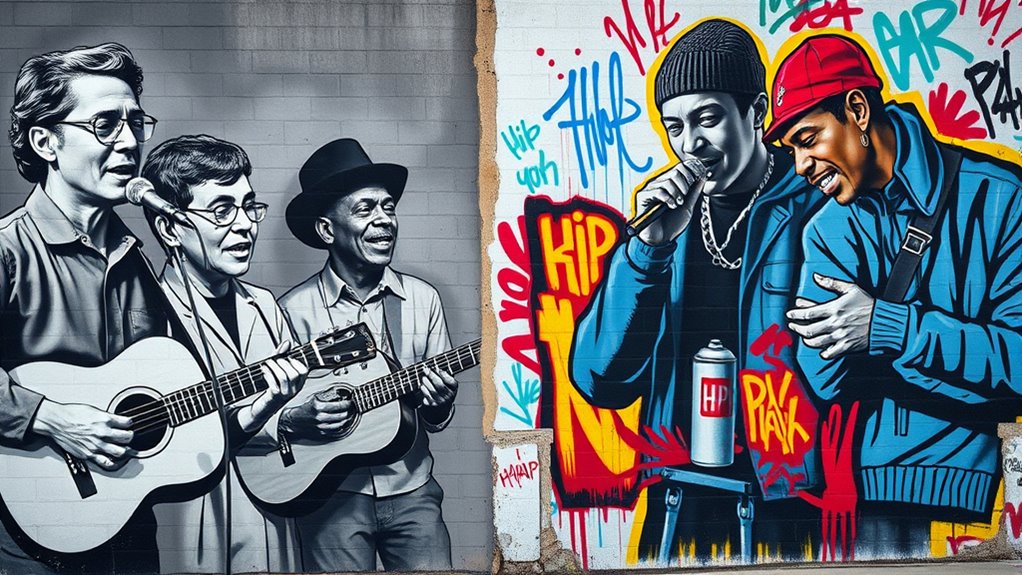
Have you ever considered how rap provides marginalized communities with a powerful voice to challenge injustices and share their stories? Rap allows these communities to express their cultural identity authentically, turning personal and collective struggles into compelling messages. It’s more than music; it’s a tool for community empowerment, giving voice to those often unheard. By highlighting issues like inequality, police brutality, and social exclusion, rap fosters solidarity and raises awareness. It enables marginalized groups to reclaim their narratives and assert their presence in the cultural landscape. Through raw, honest lyrics, rap creates a platform where voices that might otherwise remain silenced can inspire change and foster a sense of pride and resilience within their communities. Recognizing the history of protest music helps to understand how contemporary rap continues this tradition of activism and social commentary.
Contemporary Protest Music: Diversity and Digital Influence

Today’s protest music spans a wide range of genres, reflecting more voices than ever before. Social media platforms amplify these messages instantly, connecting activists worldwide. As a result, global movements gain momentum faster, transforming how resistance is expressed today. Empowering seniors with personalized in-home care also demonstrates how tailored approaches can foster greater independence and dignity for individuals.
Genre Variety Explodes
The landscape of protest music has diversified dramatically, fueled by digital platforms that enable artists from various backgrounds to share their messages instantly. This explosion of genre diversity means you now hear protest songs blending musical fusion styles—like reggae with punk or hip-hop with folk—creating fresh sounds that resonate with broader audiences. You might find artists using electronic beats to amplify messages or combining traditional instruments with modern production techniques. This variety allows you to connect with powerful messages across different musical landscapes. Additionally, the rise of hybrid styles demonstrates how artists are innovating by merging genres to better reflect complex social issues and reach diverse listeners.
- Musicians experiment freely, blending genres to reflect complex issues
- Digital platforms foster rapid, global sharing of diverse sounds
- New hybrid styles challenge traditional protest music boundaries
- Artists incorporate modern influences without losing message integrity
- The result is a vibrant, ever-evolving protest music scene that speaks to everyone
Social Media Amplifies Voices
Digital platforms have revolutionized how protest music reaches audiences, allowing voices from all walks of life to share their messages instantly. With social media influence, artists and activists launch viral campaigns that spread rapidly, amplifying their causes beyond traditional channels. You can see how a single post or hashtag can ignite widespread awareness and inspire action. Social media’s accessibility means marginalized groups now have a direct voice, bypassing mainstream gatekeepers. This digital shift fosters diversity in protest music, giving rise to new genres and perspectives. Viral campaigns create momentum, turning local issues into global movements. As a result, protest music becomes more dynamic and inclusive, reflecting a broader range of experiences and struggles. The distribution channels provided by social media platforms also enable artists to reach audiences without needing traditional media outlets, further democratizing the dissemination of protest music. Social media truly transforms how protests are organized, expressed, and amplified today.
Global Movements Rise
How have global movements shaped the landscape of protest music in recent years? They’ve fostered a rich diversity of voices, emphasizing cultural identity and inspiring artistic collaboration across borders. You’ll notice artists from different backgrounds coming together to address shared struggles, blending genres and styles to reach wider audiences. This international solidarity amplifies messages of social justice and equality.
- Artists collaborate across countries, creating powerful cultural narratives
- Music becomes a tool for global activism and awareness
- Diverse genres merge, reflecting multicultural identities
- Digital platforms help spread protest songs worldwide instantly
- Movements like Black Lives Matter and climate activism inspire worldwide musical responses
This interconnectedness fuels a more inclusive, dynamic protest music scene where cultural identity is celebrated and collaboration is key to effecting change.
Artists as Activists: Using Music to Challenge Injustice

Artists have long harnessed their music as a powerful tool to challenge injustice and inspire change. Through musical activism, they use their platform to spotlight social issues, giving voice to the marginalized. Lyrical storytelling allows artists to craft compelling narratives that resonate deeply with audiences, making complex issues personal and urgent. By integrating activism into their music, they not only raise awareness but also motivate listeners to get involved. Whether through protest songs, anthems, or subtle messages, these artists transform their art into a form of resistance. Their work becomes more than entertainment—it becomes a call to action. As activists, musicians leverage their influence to challenge societal norms and push for reforms, proving that music can be a formidable force for justice.
The Impact of Protest Music on Society and Policy
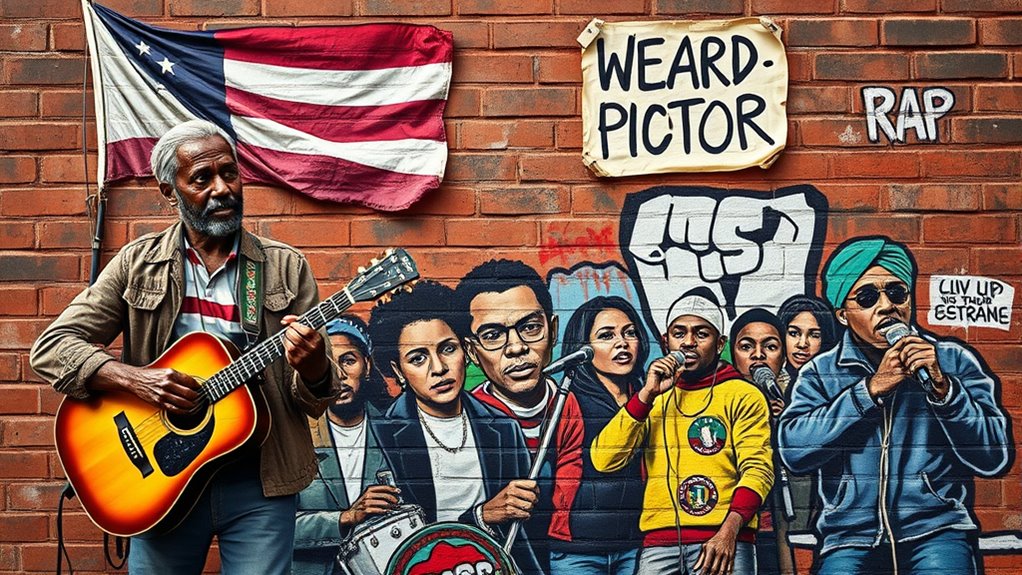
Protest music has historically shaped public opinion and influenced social change by rallying communities and inspiring collective action. Its power lies in musical innovation and listener engagement, making messages stick and spread. When a song resonates, it can spark conversations, challenge policies, and motivate activism. You might notice how iconic protest anthems have led to tangible policy shifts or increased awareness.
- They unify diverse groups around common causes
- They amplify marginalized voices
- They serve as catalysts for social movements
- They adapt with musical innovation, staying relevant
- They deepen listener engagement, making activism personal
This connection between music and society proves how influential protest songs can be, not just as art but as tools for change. Your engagement with these songs helps sustain their impact and evolve their role in shaping policy.
The Future of Protest Music in a Changing World
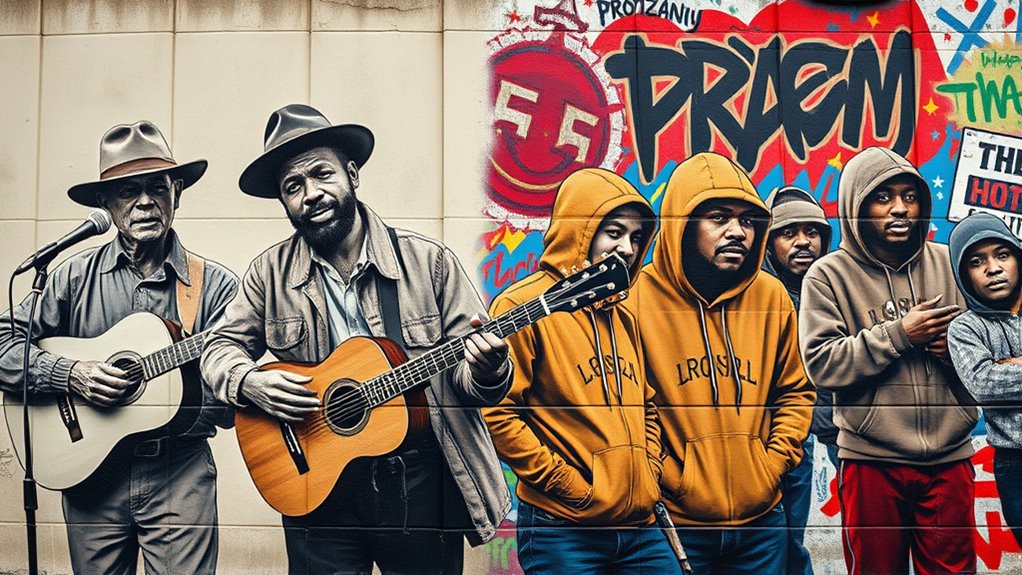
As the world continues to change rapidly, protest music is evolving to meet new challenges and opportunities. You’ll see it becoming a powerful form of cultural expression, reflecting diverse voices and experiences. Musical innovation plays a key role, blending genres like hip-hop, electronic, and global sounds to create fresh, compelling messages. Technology accelerates this evolution, allowing artists to reach wider audiences instantly and engage in real-time activism. Future protest music will likely emphasize inclusivity, amplifying marginalized voices and addressing emerging issues such as climate change and social justice. By constantly adapting and experimenting, protest music remains a crucial tool for activism, inspiring change and fostering unity amid a changing world. It’s a dynamic force that will continue to shape cultural narratives and inspire action.
Frequently Asked Questions
How Did Protest Music Influence Political Movements Globally?
You see how protest music shapes political movements worldwide by inspiring unity and raising awareness. Its cultural impact fuels activism, motivating people to demand change. Through musical evolution—from folk to rap—artists adapt their messages to resonate with different generations and issues. You realize that protest music not only reflects societal struggles but also drives social transformation, making it a powerful tool for rallying support and shaping political landscapes globally.
What Are Examples of Protest Songs That Achieved Policy Change?
Think of protest songs as sparks igniting change. You see, lyrics analysis reveals how powerful words influence opinions and policies. Artists impact movements by channeling public sentiment through compelling melodies. Examples like Bob Dylan’s “Blowin’ in the Wind” and Billie Holiday’s “Strange Fruit” led to policy shifts, proving music’s ability to shape history. When you listen and analyze, you realize how these songs become catalysts for real-world change.
How Has Technology Transformed the Dissemination of Protest Music?
Technology has revolutionized how you access and share protest music today. Digital distribution and streaming platforms make it easy for you to discover, listen to, and spread messages of activism instantly worldwide. You no longer rely solely on physical copies or radio; instead, you can amplify voices and mobilize support through social media and online platforms. This immediacy and reach empower your engagement with protest music like never before.
In What Ways Do Protest Genres Differ Across Cultures?
You notice that protest genres differ across cultures by reflecting unique cultural expressions and musical traditions. In some societies, traditional instruments and melodies emphasize community identity, while others incorporate modern styles like hip-hop or reggae to voice dissent. These differences highlight how each culture’s history and values shape its protest music, creating powerful tools for social change that resonate locally yet connect globally through shared messages of resistance.
What Role Do Social Media Platforms Play in Modern Protest Music?
Social media platforms are the heartbeat of modern protest music, turning songs into roaring waves that crash across borders. You become part of a vast, viral campaign, where every share fuels the movement. Influencers amplify messages, transforming simple tunes into powerful anthems. You see how digital tools ignite change, giving voice to the unheard and making protest music an unstoppable force in shaping societal debates today.
Conclusion
As you listen to protest music, remember it’s the heartbeat of change, echoing through generations like a persistent drum. Each song symbolizes a rallying cry, a spark igniting hope and resistance. Whether folk strums or rap verses, they’re your compass in the fight for justice. Embrace these melodies as the torchbearers guiding society’s journey, reminding you that even in silence, the spirit of protest continues to shine brightly, lighting the way forward.
